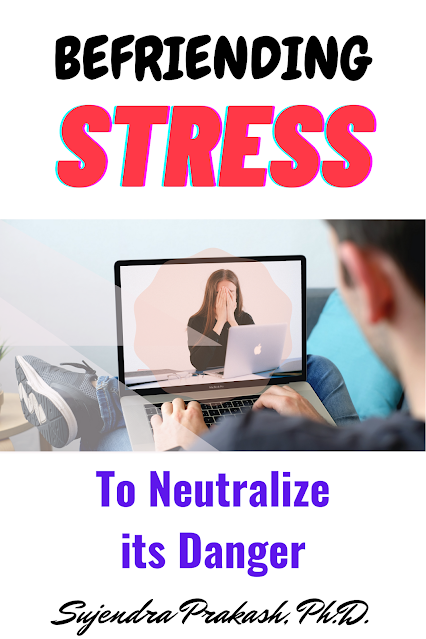WHAT IS EUSTRESS?
Why can’t we always be happy?
As pointed out earlier, there are three types of stress – Eustress, Neustress, and
Distress. Eustress exists far away from distress but with the same degree of stress. See How Are Emotions Connected to Stress?
On a continuum of stress, both these stresses are on the opposite sides. They are like mirror images. Distress is symmetrically opposite to Eustress. The happy person is also experiencing heightened stress but at a pleasurable level. This has been explained more clearly in "What is Stress?"
Happiness is not the same as Relaxation
Many may argue that
we are relaxed during these emotional states. We are not. The level of arousal
during Eustress is as high as that during distress. It is pertinent
to point out here that relaxation refers to neustress and is not the equivalent of happiness.
Being euphoric or miserable
are two sides of the same coin. In both cases, the physiological and psychological arousals are heightened.
For example, a ride on a rollercoaster may induce eustress in one person and distress in another. The latter may find it painful, unpleasant, and worrisome while the former is seen enjoying it. The emotions are opposed to each other and the type of stress is quite different but the degree of stress is similar. Very few people riding on the rollercoaster can stay relaxed, non-committal, or unconcerned.
 |
| Photo by Dana Cetojevic from Pexels |
What exactly is Eustress?
Not many of us have
heard about 'Eustress'. This was a term coined by Hans Selye in 1982, to
indicate good stress. Eustress gives us a feeling of fulfillment and
satisfaction. It is a positive state of stress that leads to emotions like joy.
This stress is pleasurable and not painful.
Some
examples of Eustress are attending a friend’s or a close relative’s
marriage ceremony, celebrating a birthday function, going on a trip, trekking
expedition, consuming tasteful food, hosting a party, social drinking with
friends, celebrating festivals, meeting a friend after several years, seeing an
entertaining movie, listening to heartful music, witnessing a dance
performance, throwing a good performance, winning a competition, playing music,
writing, reading, etc.
Simple day-to-day
activities like walking, jogging running, swimming, playing games and sports,
singing, dancing, exercising, doing yoga and meditation, wearing dresses or
jewelry, can also increase our positive feelings.
Aspiring More
One great
characteristic about Eustress is, that whichever activity gives us pleasure,
we continue to repeat it. The repetition may not be as revitalizing as the first time, but we continue to engage in these tasks, hoping to get the same
experience as in the beginning. Nevertheless, these experiences are quite
pleasant when compared to distressful events.
In all these
situations, there is a considerable amount of stress but because we are
enjoying the experience, we feel invigorated and not exhausted or fatigued.
In case our
consciousness is disturbed for some reason or the other, our enjoyment may be
curtailed. For instance, let us say you are a singer. You are singing for your satisfaction.
However, either due to someone’s pressure or your desire, the moment you enter
a singing competition, your Eustress may turn into distress. You will be
more concerned about your performance rather than your satisfaction.
Tensionless State?
We always hope that
we leave everything behind and get into a place where there are no tensions!
Can we live without
tension for even a few minutes?
Imagine a contented individual!
 |
| Photo by Samuel Theo Manat Silitonga from Pexels |
As it appears, he is enjoying the scenic beauty. But how long can anyone stay in such a peaceful environment?
Within just a few
minutes, he gets bored standing and looking at the water and sky. He would like
to sit and enjoy the view. After some time, the level of satisfaction keeps
waning.
We need other
things to increase our level of satisfaction. So, we take with us our camera to
capture nature's beauty, our book to read a few passages, our tiffin box to
munch a little, our friends and family to exchange a few pleasantries, and so
on!
It is not only the
physical things we carry with us but our thoughts and emotions. The moment we are happy for a few minutes, plenty of thoughts come to us. We remember things that
are both pleasant and unpleasant. We experience distinct emotions that last
long.
Imbalance is the key!
However, we want
imbalance! We plan to have an imbalance. We prepare ourselves to face the
imbalance.
If we are given a
chance to live happily ever after, we get bored within a few seconds!
Our purpose in life
is to keep introducing imbalance when there is a state of equilibrium in us and
strive to restore equilibrium whenever there is imbalance.
And hence, we are under stress all the time
either disturbing balance or restoring
balance
Joyfulness is temporary
Consider the case
of coffee drinkers. They start drinking coffee to reduce their tensions in
life. Gradually, they increase drinking the number of coffee cups. Even when so
many cups of coffee do not give them satisfaction, they may start smoking to
accompany their coffee consumption.
Next, smoking may
become an addiction, and they may start feeling distressed whenever they smoke.
To ward off this, they may get into drinking alcohol. Over time, they get
intoxicated and this leads to an unpleasant feeling of vomiting or hangover. To
reduce this feeling, they would like to drive their vehicle fast to get a kick
out of speeding.
When this becomes
stale, they may start drug abuse. However, they continue to keep all their
previous addictions along with the new ones and finally, they are unable to
manage themselves.
Thus, pleasantness
doesn’t stay long.
Seeking Change
Life is like sitting on a swing. No one likes to sit on a swing motionless. At some point in time, we want to tilt the balance and when the imbalance is too much to bear, we would like to stop it and restore the balance.
 |
| Photo by Artem Beliaikin from Pexels |
And we keep playing
the swing all our life.
The moment another
person is involved, we switch over to the seesaw and keep tilting the balance,
never allowing the other person to stay unmoving.
 |
| Photo by Ashish Rangwala from Pexels |
When several people are involved, we play merry-go-round. No one would like to sit or stand when the carousel is not operational. We know we are not going anywhere, but we would like to keep thinking that something meaningful is going on.
 |
| Photo by Ron Lach from Pexels |
Seeking Happiness
We are bored with
our normal lives and hate our distressful conditions. We crave happiness. This is why people spend a lot of money, time, and resources on movies
and serials, games and sports, food and drinks, etc.
Whenever we talk
about celebration, enjoyment, merriment, entertainment, etc., we are saying
that we would like to break the equilibrium. And increase our positive stress
levels.
Irrespective of how much we move out of neutrality, we return to it and restore our Neustress.
Thus, life means
stress. With stress, we feel alive. And with Eustress, we feel happy, and the cycle goes on.
Does Stress Make You Abnormal?
A new approach to understanding and dealing with stress.
Ebook on Befriending Stress – To
Neutralize its Danger.
Highlights of the Ebook
- Unique Insight
- Neustress, Eustress, and Distress
- Pressure, Conflict, and Frustration
- Emotions and Stress
- 9 Chapters in 63 Pages
- 80 Pointers to Manage Everyday Stress













Please do not include any spam links in the comment box.